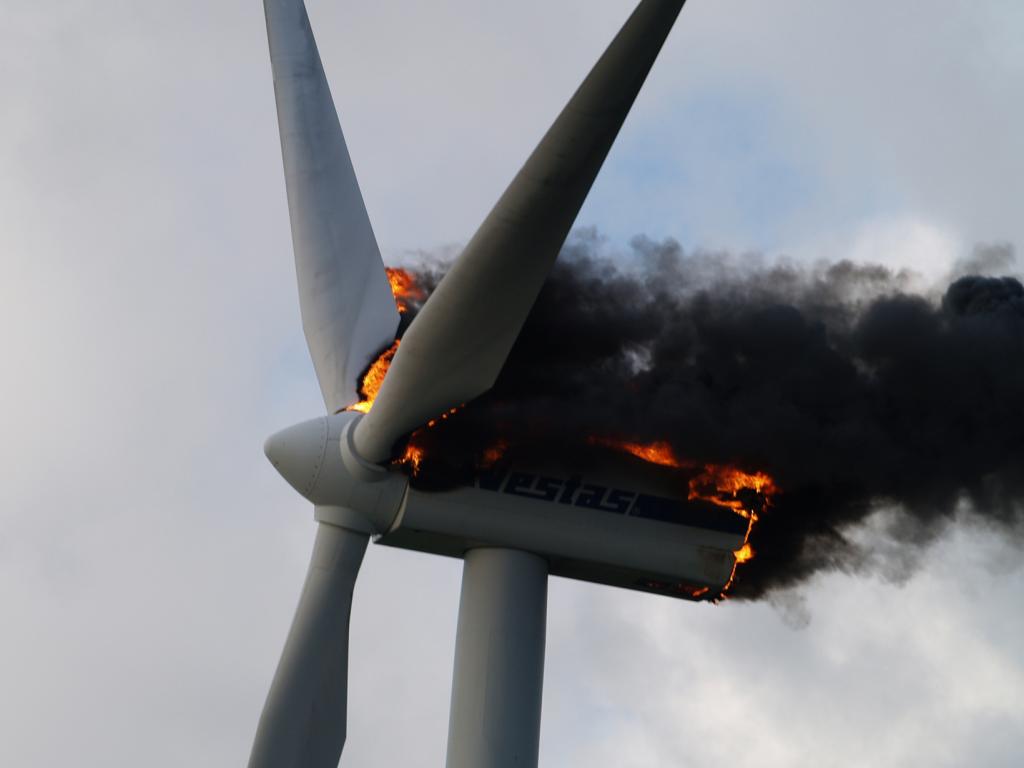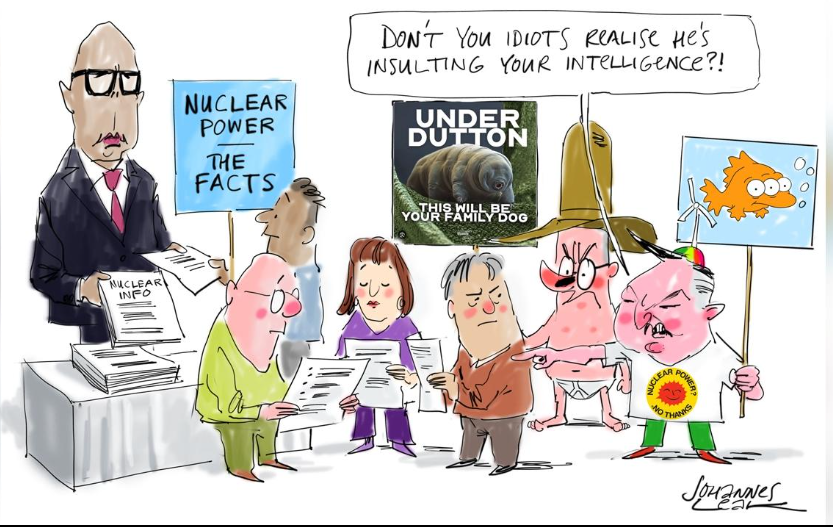The wind and sun cult’s infantile reaction to nuclear power demonstrates that it’s the generation source for grown-ups. But it’s not so much the reaction of the propagandists and cheer squad that matters, it’s the response from those profiting from the wind and solar scam that determines the political playing field from here on.
Nothing sharpens focus like real competition, even more so when that competitor will crush you every, single time. That’s what wind and solar scammers fear most from always-on, ever-reliable, CO2 emissions-free nuclear power.
The Liberal/National Coalition Leader, Peter Dutton has just announced an all-in nuclear power policy that he will take to the next Federal election, with the majority of voters already signalling their eager approval.
For crony capitalists, as they say in a Hollywood action films, ‘this shit just got real’.
Alan Moran, one of Australia’s leading energy economists, has always promoted coal-fired power on the basis of reliability and cost. And fair enough. However, in this piece Alan starts to warm to the concept of a nuclear-powered future, particularly because it would cost a mere fraction of what the current Labor all wind and solar policy will cost Australian households and businesses.
The nuclear gamble
The Spectator
Alan Moran
20 June 2024
Finally, the Opposition has announced it is going to develop a nuclear power future for Australia. The government, along with the renewables subsidy-fuelled lobby, issued howls of derision. Too expensive. The community won’t accept it. Drawing from no less an authority than a Simpsons cartoon, Energy Minister Bowen declared nuclear energy will cause mutations including three-eyed fish.
Predictably the move was panned by renewable energy investor Malcolm Turnbull, who burnished his own energy credentials in creating Snowy 2 as a $2 billion solution to the intermittency problem of wind and solar that would be up and running by 2022. Snowy 2 will cost over $20 billion, not be ready by 2030 and will only provide a minor part in firming up wind and solar.
With delicious irony on the very same day as the Opposition’s announcement, the United States Senate voted 88-2 in support of a bill to promote new nuclear power by severely reducing the regulatory impediments that have plagued the industry over the past 20 years. The Senate committee’s Chair, Democratic Senator Tom Carper, called it ‘a major victory for our climate and American energy security’.
The Biden Administration’s support for nuclear had previously been foreshadowed by Energy Secretary Jennifer Granholm. Formerly a firebrand pro-renewables politician, Granholm was mugged by reality, learning on the job that renewables mean a disaster for reliable low-cost power. Over the past month, she has called for hundreds of new nuclear power stations (the US has just 94 at present).
Notwithstanding whipped-up hysteria, nuclear generators are actually safer than wind and much safer than coal, hydro and gas (they also entail fewer greenhouse gas emissions).
Combined with its own hypocrisy in opposing nuclear power yet sponsoring floating nuclear power plants in submarines, the government’s propaganda is also coming unstuck with reports of a welcome to nuclear plants in areas where it is envisaged. The Coalition’s plan itself was devised on the basis of internal polling with those same findings.
The Opposition has had a long road to its Damascene conversion on nuclear – it was John Howard who, succumbing to Green pressure, banned it as an Australian power source in 1988.
But Howard and his ministers had an excuse. In 1998, nobody in Australia would have been under any illusion that nuclear generators, with regulatory excesses and activists’ opposition already causing cost escalations, could compete with electricity generated from the nation’s virtually unlimited low-cost coal supplies. New coal plant costs then and now were falling and new private sector power stations were being planned in Queensland (Millmerran commissioned in 2002 and Kogan Creek 2007) that were offering long-term contracts at under $40 per megawatt hour. That’s one-third of the current Australian spot price.
More importantly, in 1988 the global warming psychosis was yet to dominate the political arena.
The Opposition’s nuclear plans were clearly conceived as a means of differentiating their product from that of the ALP. A key motivation was the Coalition’s internal divisions. Dutton and Littleproud represent leftists supporting renewables (who include Littleproud himself) a strong coterie supporting coal and most of its ranks fearful of facing Green, Teal and ALP opponents who have demonstrably been able to marshal electoral support.
Nuclear is safe and, in spite of the CSIRO and Lazzards publications, as attested by the US Administration’s recent moves, is much cheaper than wind/solar. It may be the cheapest source of electricity in areas like Japan, France, and much of China and India which do not share Australia’s fabulous coal reserves. This might also be true of South and Western Australia where cheap coal is less than abundant.
But it is not the cheapest option in eastern Australia. Even with the most draconian regulatory reform nuclear would never come close to the below $50 per megawatt hour price at which new coal could be provided.
Moreover, it is far from ideal as a complementary power source to the intermittent renewables, a role seen for it by the Coalition. Wind and solar are so unreliable that they will need virtually 100 per cent back-up by controllable (dispatchable) supplies: nuclear, coal, hydro (further capacity of which is limited), gas or diesel. Such back-up is cheapest when the ratio of fuel to operating costs is lowest. Nuclear and (Australian) coal generator costs are 95 per cent fixed; they are incurred whether or not they are operating. Gas (and diesel) costs are less than 50 per cent fixed. Minister Bowen, in a rare demonstration of energy rationality, is correct in identifying gas as the complementary power source for his beloved renewables, though vastly underestimating the extent of its need.
Mr Bowen has previously put a cost of $387 billion for a nuclear-fuelled Australia, though Westinghouse Electric Company senior vice president Rita Baranwal quipped, ‘I only have three engineering degrees and that math doesn’t make sense to me,’ and put the cost at $110 billion.
Mr Dutton has said he will release the cost of his proposals before the next election (if it is held in 2025).
Neither the ALP nor previous governments have ever put a cost on the Net Zero policy. Nor have they ever disputed my estimate, currently $15.6 billion per year and growing, which would mean costs well in excess of $500 billion by 2050. The ALP program would cost at least one-third of GDP each year by 2050 – meaning everyone would be at least a third poorer.
Hopefully, if Mr Dutton prevails at the next election, Australia will buy time to come to a sensible energy policy founded on coal with some nuclear.
The Spectator
via STOP THESE THINGS
June 26, 2024 at 02:30AM



